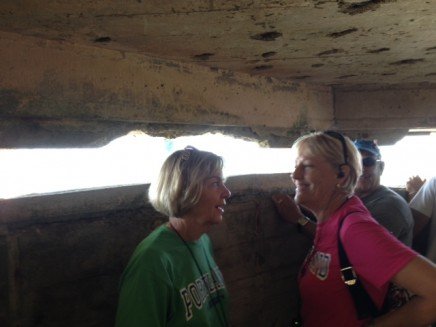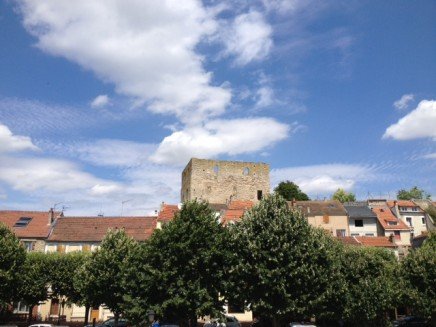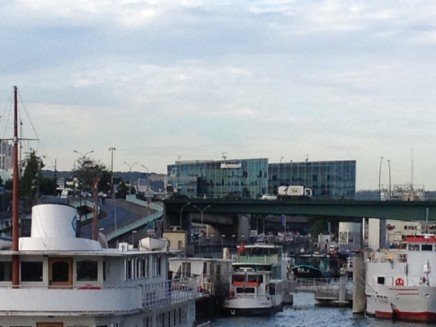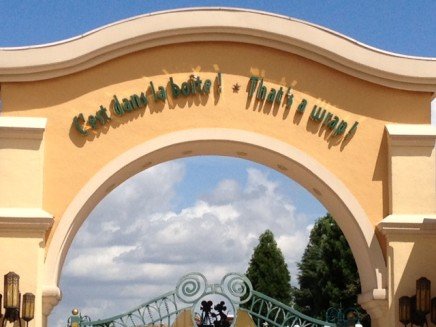Smitten Ice Cream San Francisco
2013 Summer Portland Trip
My Parents Trip to France
My parents just got back from France, and I’ve been keeping all my dad’s photos and commentary as they navigated the world. Check out their adventure below!
The adventure begins. We made it. We saw the Eiffel Tower as we were flying in. The airport is huge and modern and very clean. No problem finding our ground transportation. They were waiting for us at the airport. We came directly to the boat, had lunch, and checked into our room. We got about 1–2 hours of interrupted sleep last night, and we were dead tired (Bob and Cheryl too). We just took an hour nap, have safety orientation at 6 (remember the life vest drill) and dinner at 7, and it’s already 5:30 p.m. local time. I’m glad we are 9 hours ahead because we will both be ready for bed. The ship is beautiful, clean, and very modern. You can see the Eiffel Tower from the ship. We’ll be sending pictures but for now wanted you to know we are here even though we still haven’t totally absorbed that we are really here. It’s going to be a great experience.
A quick picture of our ship in Vernon (not pronounced like it sounds), France. A 3-day battle was fought here during WWII. The original bridge was bombed, and the town was liberated when 3 amphibious bridges were constructed here to allow the Allied forces to advance. The bombed out bridge is still visible. In town, there are bullet holes everywhere, including the sides of a beautiful cathedral. Today we dock in Hon Fleur, another historic village. As I write we are passing Rouen where Joan of Arc was burned at the stake. We stop here on our way back. Tomorrow we visit the Normandy beaches and the American cemetery, which I expect to be very emotional (Mona’s Dad was in the D-Day invasion force on Omaha beach). This has been the experience of a lifetime with lots of history, beautiful country, and amazing food. We are trying to soak it all in, knowing the time is flying by. Remember the ‘go go’ years. I’m very glad I listened and took heed about traveling while I am still able.
Omaha Beach – This was very touching. Mona had red eyes most of the time we were here, with many memories of her dad coming back and hearing story after story of the Hell our troops endured. We collected a stone from the beach for her mother and brother. This is a view from the beach just below the cemetery.
Today’s sculpture
Appetizer – Pot au fau (chicken in puff pastry)
Crypt of Richard the Lion Heart. He is not entombed here, only his heart.
Clock tower in Rouen, France — Clock dates to 1400 and only has an hour hand. Clock technology for a minute hand had not yet been invented.
Hotel built in 1345 in Rouen
Location where Joan of Arc was burned at the stake in 1431. When I studied history, I never dreamed I would visit a site like this or to be standing on the beaches of the Normandy invasion. Tomorrow we will be touring Napoleon Bonaparte’s château.
Bomb craters from Allied bombing prior to the Normandy assault. In the left foreground is a German ammunition bunker that took a direct hit.
Bunker for 16″ gun
Omaha beach memorial placed by the USA on 60th anniversary of invasion of Europe by Allies.
The message speaks for itself
Inside the cemetery
Another view of one of the 10 sections of the cemetery. Other than hearing a baby cry, you could almost cut the quietness/reverence with a knife.
Cheryl and Mona inside one of the artillery gun bunkers. Notice how narrow the openings are to help keep hand grenades from being thrown inside. The openings were 180 degrees and had 6 artillery pieces inside to cover all angles of the beach.
I’ll stop sending pics for today…. Maybe. Downtown Rouen, France.
Artisans – This afternoon we bought a hand painted porcelain tea pot at this shop. You can’t see from this picture, but this shop dates to the 1500s with the artisan sitting in the front window hand painting every piece… What an experience.
Looking down from the fortress overlooking Les Andelys. Our ship is in the background with the blue sun deck. Note the tree border around the fields. A close up shows they are rocks collected from the fields over the centuries and are now elevated making a natural fence and are called hedge rows. During WWII as the Germans retreated, they defended their retreat behind these natural barriers, causing heavy Allied casualties. They are very prevalent near the coast. This was referred to as the battles for the hedge rows.
“Downtown” Les Andelys, France, with the ruins of the fortress of Richard the Lion Heart above town.
Sitting on the deck after lunch. Here is a potion of the fortress of Conflan that you can see from the ship. If you look carefully behind the houses, you can see part of the wall.
It’s like going back in time — Sitting here having a cup of coffee and watching the landscape. You feel like you are in medieval times. It isn’t just one or two homes or churches. These views are prolific. It’s like nothing we’ve ever experienced. Heading for Les Andelys to tour the castle of Richard the Lion Heart, also known as Château Gaillard, after lunch.
Tomorrow we leave the boat and will spend the next 5 days in Paris. The boat cruise will leave us with countless great memories. This morning we visited Château Le Malmaison outside of Conflan. This was the home of Napoleon and Josephine Bonaparte. It is also our last tour as part of the cruise. Tomorrow, we leave the ship for a full day guided tour of Paris that was included with our cruise. A point of trivia- translated in English, Napoleon’s home is translated ‘bad house’. It was a fine looking home to me!!
We docked next door to the National Atmospheric Observatory, and they have a balloon in the air above us with a huge basket. I count over 30 people in the basket to give you an indication of its size.
This one is just for you, Jeremy, Microsoft France.
The Statue of Liberty….in France
Life is very good!
Loose interpretation- check out this cool menu. What sounds good for lunch?
Literal interpretation- Can anyone read French menus?
We are now in the real France, but having a lot of fun understanding (or trying to understand) a totally new culture.
I wasn’t kidding when I said the entire City of Paris was there. We were standing in line this am, and we’re told 3 hours to get to the entrance. Someone said to view the back gardens and the lines were usually shorter after lunch. We spent about 3 hours walking just a portion of the gardens and came back and were told 3 1/2 to 4 hours. Guess what? We could die in the sun or leave. We will probably regret it, but we left with lots of pics of the outside.
Try to guess what everyone is trying to get a picture of. Answer is on next email.
Everyone was trying to get a picture with the famous Ron and Mona Person.
The picture in the background of Mona Lisa might have been a bit of a distraction!! Unbelievable crowd!
Up as close as security would allow
The Louvre
Arch D’ Triomphe
Disneyland! We had fun just because we are all Disney fans. It’s smaller and attractions were sometimes a bit different. For example, the Temple of Doom (Temple Du Peril) was a roller coaster with part of the ride coming outside the bldg. Also, the Disney studio was totally different than the California park in the USA, with different presentations and rides. It also wasn’t as clean. We still had fun but agreed it wasn’t the same high quality experience we are accustomed to seeing.
Look who’s still going strong? Tomorrow is our last day before flying home Wednesday. We have mixed emotions about leaving, but know we eventually have a life to get back to in Oregon, but we’ve had an awesome time in France. I have over 1,300 pictures to put you to sleep with!!
Looking straight up at the Eiffel Tower
Today’s transportation — Over 50 stops available to get on and off. A great way to see Paris. Tomorrow we are going to the Palace of Versailles. We’ve had several showers but all at night. It rained hard this am, but the sun was out by 8 am. The problem was it was 100 degrees with humidity nearly as high. Oh, well. Beats trying to see Paris in the rain.
How hot was it? This poor dog was standing on this air vent in the sidewalk trying to cool off. His ears were flying in the breeze.
We went to the Palace of Versailles along with the entire City of Gay Paris. It was packed, as you will soon see. This is overlooking a tiny portion of Louis XIV’s gardens. We estimated we were looking out 3 miles (ca. 5 km) and weren’t at the end of the estate.
I ordered café gourmand. It was tiramisu, strawberry mousse, a brownie, and a shot of espresso. Life is very good.
No commentary needed
First stop today was the Moulin Rouge caberet. We didn’t see a performance. Just wanted to see the historic venue.
Lunch at Hard Rock Café…… And a couple t-shirts.
We put our padlock on the padlock bridge (tell you the story at home) and threw away the key into the Seine.
Memorial to Princess Diana. This is the tunnel where her car crashed. The flame is from the original Statue of Liberty in France.
This will most likely be the last picture from France. Tomorrow night (Wednesday) we should be back home in Portland. We affectionately called our vacation by three names- our Tour de France, Ground Hog Day, and the Never Ending vacation. Well, it’s about to end. It’s been nothing short of amazing. As we left Disney Studios Monday, this was the sign over the exit, and it pretty well sums up two amazing weeks- “That’s a wrap.”
























































































